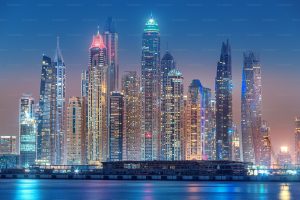The Grand Mosque Services
Attractions
Holy Sites
Accommodation
Shopping
Restaurants and Cafes
Getting to Makkah
Holy site
Makkah is the holiest city for Muslims. It embraces Masjid Al Haram (the GreatMosque) and Kaaba, the qiblah for Muslims to which they turn in their prayers. Muslims yearn to visit Makkah to perform Hajj or Umrah. In this city, Prophet Muhammad, the most honorable of creation, the seal of the prophets and messengers, our master Muhammad, peace be upon him, was born, and from it, the tolerant message of Islam was launched to all corners of the world after the Holy Quran was revealed. Makkah is located in the western part of Saudi Arabia. During the reign of the kings of Saudi Arabia, it received great interest. Makkah still enjoys great attentionto provide the best services to pilgrims. Its most prominent landmark, Masjid Al Haram, witnessed many expansions that included all parts of the mosque, and the holy sites received a series of development works to provide all means of comfort and reassurance for all pilgrims from inside and outside the Kingdom..
The Grand Mosque

Sections of the Grand Mosque of Makkah
Ka’bah courtyard or Mataf: It is the courtyard tiled with white marble that surrounds the honorable Ka’bah. Currently, it is called the “courtyard,” in which Muslims walk around the Kab’ah. It is also called Mataf (circumambulation area), which refers to the act of going around the Ka’bah.
The Abbasid corridor dates back to the reign of the Abbasid Caliph Muhammad al-Mahdi. This corridor has undergone many innovations down the ages and during the Saudi expansions of the Grand Mosque of Makkah.
Saudi leaders have prioritized improving and expanding the Grand Mosque of Makkah to keep pace with the increasing number of Hajj and ‘Umrah pilgrims. During the reign of King Saud, the first expansions of the Grand Mosque were commenced in 1375 AH. The Grand Mosque was further expanded in 1409 and in 1428AH.
In the second Saudi expansion, large courtyards surrounding the Grand Mosque were created and prepared for prayer, especially during the crowded seasons. They were tiled with heat-resisting marble.
The second Saudi expansion exploited the roof of the Grand Mosque. The roof was tiled with heat-resisting marble. In the third Saudi expansion, escalators were installed to carry worshipers to the roof and the first floor during Hajj-high and crowded seasons.
Many gates lead to the courtyard of the Grand Mosque. Each Gate has a specific number. Above each gate, a light panel, recognizable from a distance, displays either an entry or exit sign.

Sections of the Grand Mosque of Makkah
Ka’bah courtyard or Mataf: It is the courtyard tiled with white marble that surrounds the honorable Ka’bah. Currently, it is called the “courtyard,” in which Muslims walk around the Kab’ah. It is also called Mataf (circumambulation area), which refers to the act of going around the Ka’bah.
The Abbasid corridor dates back to the reign of the Abbasid Caliph Muhammad al-Mahdi. This corridor has undergone many innovations down the ages and during the Saudi expansions of the Grand Mosque of Makkah.
Saudi leaders have prioritized improving and expanding the Grand Mosque of Makkah to keep pace with the increasing number of Hajj and ‘Umrah pilgrims. During the reign of King Saud, the first expansions of the Grand Mosque were commenced in 1375 AH. The Grand Mosque was further expanded in 1409 and in 1428AH.
In the second Saudi expansion, large courtyards surrounding the Grand Mosque were created and prepared for prayer, especially during the crowded seasons. They were tiled with heat-resisting marble.
The second Saudi expansion exploited the roof of the Grand Mosque. The roof was tiled with heat-resisting marble. In the third Saudi expansion, escalators were installed to carry worshipers to the roof and the first floor during Hajj-high and crowded seasons.
Many gates lead to the courtyard of the Grand Mosque. Each Gate has a specific number. Above each gate, a light panel, recognizable from a distance, displays either an entry or exit sign.

Sections of the Grand Mosque of Makkah
Ka’bah courtyard or Mataf: It is the courtyard tiled with white marble that surrounds the honorable Ka’bah. Currently, it is called the “courtyard,” in which Muslims walk around the Kab’ah. It is also called Mataf (circumambulation area), which refers to the act of going around the Ka’bah.
The Abbasid corridor dates back to the reign of the Abbasid Caliph Muhammad al-Mahdi. This corridor has undergone many innovations down the ages and during the Saudi expansions of the Grand Mosque of Makkah.
Saudi leaders have prioritized improving and expanding the Grand Mosque of Makkah to keep pace with the increasing number of Hajj and ‘Umrah pilgrims. During the reign of King Saud, the first expansions of the Grand Mosque were commenced in 1375 AH. The Grand Mosque was further expanded in 1409 and in 1428AH.
In the second Saudi expansion, large courtyards surrounding the Grand Mosque were created and prepared for prayer, especially during the crowded seasons. They were tiled with heat-resisting marble.
The second Saudi expansion exploited the roof of the Grand Mosque. The roof was tiled with heat-resisting marble. In the third Saudi expansion, escalators were installed to carry worshipers to the roof and the first floor during Hajj-high and crowded seasons.
Many gates lead to the courtyard of the Grand Mosque. Each Gate has a specific number. Above each gate, a light panel, recognizable from a distance, displays either an entry or exit sign.

Sections of the Grand Mosque of Makkah
Ka’bah courtyard or Mataf: It is the courtyard tiled with white marble that surrounds the honorable Ka’bah. Currently, it is called the “courtyard,” in which Muslims walk around the Kab’ah. It is also called Mataf (circumambulation area), which refers to the act of going around the Ka’bah.
The Abbasid corridor dates back to the reign of the Abbasid Caliph Muhammad al-Mahdi. This corridor has undergone many innovations down the ages and during the Saudi expansions of the Grand Mosque of Makkah.
Saudi leaders have prioritized improving and expanding the Grand Mosque of Makkah to keep pace with the increasing number of Hajj and ‘Umrah pilgrims. During the reign of King Saud, the first expansions of the Grand Mosque were commenced in 1375 AH. The Grand Mosque was further expanded in 1409 and in 1428AH.
In the second Saudi expansion, large courtyards surrounding the Grand Mosque were created and prepared for prayer, especially during the crowded seasons. They were tiled with heat-resisting marble.
The second Saudi expansion exploited the roof of the Grand Mosque. The roof was tiled with heat-resisting marble. In the third Saudi expansion, escalators were installed to carry worshipers to the roof and the first floor during Hajj-high and crowded seasons.
Many gates lead to the courtyard of the Grand Mosque. Each Gate has a specific number. Above each gate, a light panel, recognizable from a distance, displays either an entry or exit sign.
The Grand’s Mosque Services

Zamzam
Zamzam water is one of Allah’s blessings on Makkah and its visitors. Allah bestowed it on..Isma’il, peace be upon him, and his mother Hagar, when Abrahim, peace be upon him, left them in Makkah in response to Allah’s command to him. Then, he supplicated to his Lord, saying: ”Our Lord! verity I have settled some of my posterity in an uncultivable valley near unto Your Sacred House. Our Lord! that they may establish the prayer; so incline some hearts of men that they may yearn toward them, and provide them with fruits in order that they may be thankful.”
Read More >

Guide Signs
Zamzam water is one of Allah’s blessings on Makkah and its visitors. Allah bestowed it on..Isma’il, peace be upon him, and his mother Hagar, when Abrahim, peace be upon him, left them in Makkah in response to Allah’s command to him. Then, he supplicated to his Lord, saying: ”Our Lord! verity I have settled some of my posterity in an uncultivable valley near unto Your Sacred House. Our Lord! that they may establish the prayer; so incline some hearts of men that they may yearn toward them, and provide them with fruits in order that they may be thankful.”
Read More >

Escalators
Zamzam water is one of Allah’s blessings on Makkah and its visitors. Allah bestowed it on..Isma’il, peace be upon him, and his mother Hagar, when Abrahim, peace be upon him, left them in Makkah in response to Allah’s command to him. Then, he supplicated to his Lord, saying: ”Our Lord! verity I have settled some of my posterity in an uncultivable valley near unto Your Sacred House. Our Lord! that they may establish the prayer; so incline some hearts of men that they may yearn toward them, and provide them with fruits in order that they may be thankful.”
Read More >

Fatwa Services
Zamzam water is one of Allah’s blessings on Makkah and its visitors. Allah bestowed it on..Isma’il, peace be upon him, and his mother Hagar, when Abrahim, peace be upon him, left them in Makkah in response to Allah’s command to him. Then, he supplicated to his Lord, saying: ”Our Lord! verity I have settled some of my posterity in an uncultivable valley near unto Your Sacred House. Our Lord! that they may establish the prayer; so incline some hearts of men that they may yearn toward them, and provide them with fruits in order that they may be thankful.”
Read More >

Zamzam
Zamzam water is one of Allah’s blessings on Makkah and its visitors. Allah bestowed it on..Isma’il, peace be upon him, and his mother Hagar, when Abrahim, peace be upon him, left them in Makkah in response to Allah’s command to him. Then, he supplicated to his Lord, saying: ”Our Lord! verity I have settled some of my posterity in an uncultivable valley near unto Your Sacred House. Our Lord! that they may establish the prayer; so incline some hearts of men that they may yearn toward them, and provide them with fruits in order that they may be thankful.”
Read More >

Guide Signs
Zamzam water is one of Allah’s blessings on Makkah and its visitors. Allah bestowed it on..Isma’il, peace be upon him, and his mother Hagar, when Abrahim, peace be upon him, left them in Makkah in response to Allah’s command to him. Then, he supplicated to his Lord, saying: ”Our Lord! verity I have settled some of my posterity in an uncultivable valley near unto Your Sacred House. Our Lord! that they may establish the prayer; so incline some hearts of men that they may yearn toward them, and provide them with fruits in order that they may be thankful.”
Read More >

Escalators
Zamzam water is one of Allah’s blessings on Makkah and its visitors. Allah bestowed it on..Isma’il, peace be upon him, and his mother Hagar, when Abrahim, peace be upon him, left them in Makkah in response to Allah’s command to him. Then, he supplicated to his Lord, saying: ”Our Lord! verity I have settled some of my posterity in an uncultivable valley near unto Your Sacred House. Our Lord! that they may establish the prayer; so incline some hearts of men that they may yearn toward them, and provide them with fruits in order that they may be thankful.”
Read More >

Fatwa Services
Zamzam water is one of Allah’s blessings on Makkah and its visitors. Allah bestowed it on..Isma’il, peace be upon him, and his mother Hagar, when Abrahim, peace be upon him, left them in Makkah in response to Allah’s command to him. Then, he supplicated to his Lord, saying: ”Our Lord! verity I have settled some of my posterity in an uncultivable valley near unto Your Sacred House. Our Lord! that they may establish the prayer; so incline some hearts of men that they may yearn toward them, and provide them with fruits in order that they may be thankful.”
Read More >
Attractions

Mount Noor (Jabal An-No..
Mount Noor is the place where Allah honored His Prophet Muhammad (blessings and.. peace be upon him) with prophethood. This is where he used to spend his time in worship of his Lord and in contemplation of Allah’s creation.
Read More >

Thawr Mount and Cave
The cave of Thawr is the small cave in which the Messenger of Allah (blessings and peace be.. upon him) stayed with his companion Abu Bakr as-Siddiq – may Allah be pleased with him – for three nights during his migration to Madinah, hiding from the eyes of the polytheists, while Allah protected and preserved him.
Read More >

Hira Cultural District
The cave of Thawr is the small cave in which the Messenger of Allah (blessings and peace be.. upon him) stayed with his companion Abu Bakr as-Siddiq – may Allah be pleased with him – for three nights during his migration to Madinah, hiding from the eyes of the polytheists, while Allah protected and preserved him.
Read More >

Namerah Mosque
Namerah Mosque is one of the most important landmarks in Arafah. On the day of Arafah, thousands of pilgrims who come from all over the world pray in this mosque.
Read More >

Mount Noor (Jabal An-No..
Mount Noor is the place where Allah honored His Prophet Muhammad (blessings and.. peace be upon him) with prophethood. This is where he used to spend his time in worship of his Lord and in contemplation of Allah’s creation.
Read More >

Thawr Mount and Cave
The cave of Thawr is the small cave in which the Messenger of Allah (blessings and peace be.. upon him) stayed with his companion Abu Bakr as-Siddiq – may Allah be pleased with him – for three nights during his migration to Madinah, hiding from the eyes of the polytheists, while Allah protected and preserved him.
Read More >

Thawr Mount and Cave
The cave of Thawr is the small cave in which the Messenger of Allah (blessings and peace be.. upon him) stayed with his companion Abu Bakr as-Siddiq – may Allah be pleased with him – for three nights during his migration to Madinah, hiding from the eyes of the polytheists, while Allah protected and preserved him.
Read More >

Namerah Mosque
Namerah Mosque is one of the most important landmarks in Arafah. On the day of Arafah, thousands of pilgrims who come from all over the world pray in this mosque.
Read More >
Holy Sites

Mina
A stage of Hajj journey. It is characterized by white tents. It has recently won the Guinness World Records Award for the largest tent city in the world. It provides many services, including the Mashaer Train, housing camps, catering, transportation system, integrated electricity system, and interconnected road network. Pilgrims usually spend the Day of Tarwiyah (the eighth day of Dhu al-Hijjah) there and return to Mina again to spend Day of Nahr (the tenth day of Dhu al-Hijjah) and the three days of Tashreeq (the eleventh, the twelfth, and thirteenth days of Dhul-Hijjah). Mina is the first stage of Hajj. It has a historical and religious status. It is famous for archaeological landmarks and historical events, as it is located within the boundaries of the Haram between Makkah and Muzdalifah, 7 km to the northeast of the Holy Mosque. Mina also includes the extension of “Ain Zubaida,” in addition to some old wells, including the well of Kadana. Mina is famous for the historical seasonal markets, including the Arab Market, which was given this name because most Arab pilgrims used to display their goods at this market from the tenth day to the thirteenth day of Dhu al-Hijjah.
Read More >

Mina
A stage of Hajj journey. It is characterized by white tents. It has recently won the Guinness World Records Award for the largest tent city in the world. It provides many services, including the Mashaer Train, housing camps, catering, transportation system, integrated electricity system, and interconnected road network. Pilgrims usually spend the Day of Tarwiyah (the eighth day of Dhu al-Hijjah) there and return to Mina again to spend Day of Nahr (the tenth day of Dhu al-Hijjah) and the three days of Tashreeq (the eleventh, the twelfth, and thirteenth days of Dhul-Hijjah). Mina is the first stage of Hajj. It has a historical and religious status. It is famous for archaeological landmarks and historical events, as it is located within the boundaries of the Haram between Makkah and Muzdalifah, 7 km to the northeast of the Holy Mosque. Mina also includes the extension of “Ain Zubaida,” in addition to some old wells, including the well of Kadana. Mina is famous for the historical seasonal markets, including the Arab Market, which was given this name because most Arab pilgrims used to display their goods at this market from the tenth day to the thirteenth day of Dhu al-Hijjah.
Read More >

Mina
A stage of Hajj journey. It is characterized by white tents. It has recently won the Guinness World Records Award for the largest tent city in the world. It provides many services, including the Mashaer Train, housing camps, catering, transportation system, integrated electricity system, and interconnected road network. Pilgrims usually spend the Day of Tarwiyah (the eighth day of Dhu al-Hijjah) there and return to Mina again to spend Day of Nahr (the tenth day of Dhu al-Hijjah) and the three days of Tashreeq (the eleventh, the twelfth, and thirteenth days of Dhul-Hijjah). Mina is the first stage of Hajj. It has a historical and religious status. It is famous for archaeological landmarks and historical events, as it is located within the boundaries of the Haram between Makkah and Muzdalifah, 7 km to the northeast of the Holy Mosque. Mina also includes the extension of “Ain Zubaida,” in addition to some old wells, including the well of Kadana. Mina is famous for the historical seasonal markets, including the Arab Market, which was given this name because most Arab pilgrims used to display their goods at this market from the tenth day to the thirteenth day of Dhu al-Hijjah.
Read More >

Mina
A stage of Hajj journey. It is characterized by white tents. It has recently won the Guinness World Records Award for the largest tent city in the world. It provides many services, including the Mashaer Train, housing camps, catering, transportation system, integrated electricity system, and interconnected road network. Pilgrims usually spend the Day of Tarwiyah (the eighth day of Dhu al-Hijjah) there and return to Mina again to spend Day of Nahr (the tenth day of Dhu al-Hijjah) and the three days of Tashreeq (the eleventh, the twelfth, and thirteenth days of Dhul-Hijjah). Mina is the first stage of Hajj. It has a historical and religious status. It is famous for archaeological landmarks and historical events, as it is located within the boundaries of the Haram between Makkah and Muzdalifah, 7 km to the northeast of the Holy Mosque. Mina also includes the extension of “Ain Zubaida,” in addition to some old wells, including the well of Kadana. Mina is famous for the historical seasonal markets, including the Arab Market, which was given this name because most Arab pilgrims used to display their goods at this market from the tenth day to the thirteenth day of Dhu al-Hijjah.
Read More >

Mina
A stage of Hajj journey. It is characterized by white tents. It has recently won the Guinness World Records Award for the largest tent city in the world. It provides many services, including the Mashaer Train, housing camps, catering, transportation system, integrated electricity system, and interconnected road network. Pilgrims usually spend the Day of Tarwiyah (the eighth day of Dhu al-Hijjah) there and return to Mina again to spend Day of Nahr (the tenth day of Dhu al-Hijjah) and the three days of Tashreeq (the eleventh, the twelfth, and thirteenth days of Dhul-Hijjah). Mina is the first stage of Hajj. It has a historical and religious status. It is famous for archaeological landmarks and historical events, as it is located within the boundaries of the Haram between Makkah and Muzdalifah, 7 km to the northeast of the Holy Mosque. Mina also includes the extension of “Ain Zubaida,” in addition to some old wells, including the well of Kadana. Mina is famous for the historical seasonal markets, including the Arab Market, which was given this name because most Arab pilgrims used to display their goods at this market from the tenth day to the thirteenth day of Dhu al-Hijjah.
Read More >
Accommodation

Al Safwah
Located opposite the King Abdul Aziz Gate in Makkah, Al Safwah Hotel offers modern and upscale accommodation in a tall building in the Grand Mosque. Provide free Wi-Fi service. The rooms at Al Safwa Royal Orchid Hotel are furnished with contemporary furniture and are equipped with a flat-screen TV with satellite channels. They are all air-conditioned and have an en suite bathroom with selected toiletries.
Read More >

Raffles
Zamzam water is one of Allah’s blessings on Makkah and its visitors. Allah bestowed it on..Isma’il, peace be upon him, and his mother Hagar, when Abrahim, peace be upon him, left them in Makkah in response to Allah’s command to him. Then, he supplicated to his Lord, saying: ”Our Lord! verity I have settled some of my posterity in an uncultivable valley near unto Your Sacred House. Our Lord! that they may establish the prayer; so incline some hearts of men that they may yearn toward them, and provide them with fruits in order that they may be thankful.”
Read More >

Fairmont
Fairmont hotel is located just 100 meters from the Holy Mosque, inside the Makkah Al Mukarramah Clock Tower, and is considered one of the tallest buildings in the world. It features a fully equipped fitness center, hot tub, sauna, and steam room. It offers concierge services around the clock.
Read More >

Hilton Suites
Hilton Suites is located in the heart of the holy city of Makkah, overlooking the Holy Haram. Free Wi-Fi and separate private mosques for men and women on the hotel premises.
Read More >

Al Safwah
Located opposite the King Abdul Aziz Gate in Makkah, Al Safwah Hotel offers modern and upscale accommodation in a tall building in the Grand Mosque. Provide free Wi-Fi service. The rooms at Al Safwa Royal Orchid Hotel are furnished with contemporary furniture and are equipped with a flat-screen TV with satellite channels. They are all air-conditioned and have an en suite bathroom with selected toiletries.
Read More >

Raffles
Zamzam water is one of Allah’s blessings on Makkah and its visitors. Allah bestowed it on..Isma’il, peace be upon him, and his mother Hagar, when Abrahim, peace be upon him, left them in Makkah in response to Allah’s command to him. Then, he supplicated to his Lord, saying: ”Our Lord! verity I have settled some of my posterity in an uncultivable valley near unto Your Sacred House. Our Lord! that they may establish the prayer; so incline some hearts of men that they may yearn toward them, and provide them with fruits in order that they may be thankful.”
Read More >

Fairmont
Fairmont hotel is located just 100 meters from the Holy Mosque, inside the Makkah Al Mukarramah Clock Tower, and is considered one of the tallest buildings in the world. It features a fully equipped fitness center, hot tub, sauna, and steam room. It offers concierge services around the clock.
Read More >

Hilton Suites
Hilton Suites is located in the heart of the holy city of Makkah, overlooking the Holy Haram. Free Wi-Fi and separate private mosques for men and women on the hotel premises.
Read More >
Shopping

Makkah Mall
Makkah Mall, one of the most important malls in Makkah, is a large and diverse commercial complex that owns a large number of local and international stores for clothes, shoes, perfumes and accessories. It also contains a group of international restaurants serving fast food and international cafes, in addition to a play area for young and old.
Read More >

Souk Al Diyafa
Souk Al Diyafa is one of the most famous shopping places in the city of Makkah, as it contains a large group of shops, which include many goods of the best brands, whether local or international.
Read More >

Muzdalifah
Souk Al-Khalil -1 opened in 2013, located under Jabal Omar Hilton Suites Makkah – and Jabal Omar Hyatt Regency Makkah just steps away from the Grand Mosque (Masjid Al-Haram), Souk Al-Khalil -1 is one of the biggest commercial centers in Jabal Omar destination, where it features a diverse mix of retailers ranging from international retailers and local favorites to high-end boutiques. The selection of brands includes Abdul Samad Al-Qurashi, Footlocker, and MotherCare, in addition to luxury retailers such as Rolex, Sephora, and more.
Read More >

Souk Al-Khalil
According to a source at the branch of the Ministry of Commerce and Investment in Makkah, souvenirs and antiques of Al-Haram were confiscated and the violating shops were notified of the consequences of the act to preserve the sanctity of these places.
Read More >

Makkah Mall
Makkah Mall, one of the most important malls in Makkah, is a large and diverse commercial complex that owns a large number of local and international stores for clothes, shoes, perfumes and accessories. It also contains a group of international restaurants serving fast food and international cafes, in addition to a play area for young and old.
Read More >

Souk Al Diyafa
Souk Al Diyafa is one of the most famous shopping places in the city of Makkah, as it contains a large group of shops, which include many goods of the best brands, whether local or international.
Read More >

Muzdalifah
Souk Al-Khalil -1 opened in 2013, located under Jabal Omar Hilton Suites Makkah – and Jabal Omar Hyatt Regency Makkah just steps away from the Grand Mosque (Masjid Al-Haram), Souk Al-Khalil -1 is one of the biggest commercial centers in Jabal Omar destination, where it features a diverse mix of retailers ranging from international retailers and local favorites to high-end boutiques. The selection of brands includes Abdul Samad Al-Qurashi, Footlocker, and MotherCare, in addition to luxury retailers such as Rolex, Sephora, and more.
Read More >

Souk Al-Khalil
According to a source at the branch of the Ministry of Commerce and Investment in Makkah, souvenirs and antiques of Al-Haram were confiscated and the violating shops were notified of the consequences of the act to preserve the sanctity of these places.
Read More >
Restaurants and Cafes

Maqam
Very few restaurants do not open in the early morning in Makkah, but a Maqam cafe is one of the few places that is characterized by serving Arabic, Turkish and American breakfast, and they have a group of Saudi chefs who serve the most delicious dishes, sweets, and Turkish coffee.
Getting to Makkah

From Taif International Airport
Lorem ipsum dolor sit amet, consectetur adipiscing elit, sed do eiusmod tempor incididunt ut labore et dolore magna aliqua. Ut enim ad minim veniam, quis nostrud exercitation ullamco laboris nisi ut aliquip ex ea commodo consequat. Duis aute irure dolor in reprehenderit in voluptate velit esse cillum dolore eu fugiat nulla pariatur. Excepteur sint occaecat cupidatat non proident, sunt in culpa qui officia deserunt mollit anim id est laborum.
Lorem ipsum dolor sit amet, consectetur adipiscing elit, sed do eiusmod tempor incididunt ut labore et dolore magna aliqua. Ut enim ad minim veniam, quis nostrud exercitation ullamco laboris nisi ut aliquip ex ea commodo consequat. Duis aute irure dolor in reprehenderit in voluptate velit esse cillum dolore eu fugiat nulla pariatur. Excepteur sint occaecat cupidatat non proident, sunt in culpa qui officia deserunt mollit anim id est laborum.

From Taif International Airport
Lorem ipsum dolor sit amet, consectetur adipiscing elit, sed do eiusmod tempor incididunt ut labore et dolore magna aliqua. Ut enim ad minim veniam, quis nostrud exercitation ullamco laboris nisi ut aliquip ex ea commodo consequat. Duis aute irure dolor in reprehenderit in voluptate velit esse cillum dolore eu fugiat nulla pariatur. Excepteur sint occaecat cupidatat non proident, sunt in culpa qui officia deserunt mollit anim id est laborum.
Lorem ipsum dolor sit amet, consectetur adipiscing elit, sed do eiusmod tempor incididunt ut labore et dolore magna aliqua. Ut enim ad minim veniam, quis nostrud exercitation ullamco laboris nisi ut aliquip ex ea commodo consequat. Duis aute irure dolor in reprehenderit in voluptate velit esse cillum dolore eu fugiat nulla pariatur. Excepteur sint occaecat cupidatat non proident, sunt in culpa qui officia deserunt mollit anim id est laborum.

From Taif International Airport
Lorem ipsum dolor sit amet, consectetur adipiscing elit, sed do eiusmod tempor incididunt ut labore et dolore magna aliqua. Ut enim ad minim veniam, quis nostrud exercitation ullamco laboris nisi ut aliquip ex ea commodo consequat. Duis aute irure dolor in reprehenderit in voluptate velit esse cillum dolore eu fugiat nulla pariatur. Excepteur sint occaecat cupidatat non proident, sunt in culpa qui officia deserunt mollit anim id est laborum.
Lorem ipsum dolor sit amet, consectetur adipiscing elit, sed do eiusmod tempor incididunt ut labore et dolore magna aliqua. Ut enim ad minim veniam, quis nostrud exercitation ullamco laboris nisi ut aliquip ex ea commodo consequat. Duis aute irure dolor in reprehenderit in voluptate velit esse cillum dolore eu fugiat nulla pariatur. Excepteur sint occaecat cupidatat non proident, sunt in culpa qui officia deserunt mollit anim id est laborum.

From Taif International Airport
Lorem ipsum dolor sit amet, consectetur adipiscing elit, sed do eiusmod tempor incididunt ut labore et dolore magna aliqua. Ut enim ad minim veniam, quis nostrud exercitation ullamco laboris nisi ut aliquip ex ea commodo consequat. Duis aute irure dolor in reprehenderit in voluptate velit esse cillum dolore eu fugiat nulla pariatur. Excepteur sint occaecat cupidatat non proident, sunt in culpa qui officia deserunt mollit anim id est laborum.
Lorem ipsum dolor sit amet, consectetur adipiscing elit, sed do eiusmod tempor incididunt ut labore et dolore magna aliqua. Ut enim ad minim veniam, quis nostrud exercitation ullamco laboris nisi ut aliquip ex ea commodo consequat. Duis aute irure dolor in reprehenderit in voluptate velit esse cillum dolore eu fugiat nulla pariatur. Excepteur sint occaecat cupidatat non proident, sunt in culpa qui officia deserunt mollit anim id est laborum.
Umrah in a Nutshell

What is the Umrah?
Umrah is an act of worshipping Allah by entering the state of Ihram, circumambulating the House, running between Safa and Marwa, and having the head shaved or trimmed.
How do I enter into the state of Ihram?
- A Muslim enters into the state of Ihram at the place specified by Sharia, and shall abstain from the Ihram prohibitions
- He shall recite Talbiyah, saying: “Labbayka Allaahumma Labbayk, Labbayka La Shareeka Laka Labbayk. Innal Hamda Wan-ni’mata Laka Wal-Mulk, La Shareeka Lak” (Here I am at your service, o Allah, at Your service! At Your service! You have no partner! I am at Your service! Indeed, all praise and grace belong to You, and so does the supreme authority. You have no partner)
Circumambulation (Tawaf):
- He/she goes to the Haram
- When the Kaaba is to the left, they circumambulate (counterclockwise)
- He begins and ends at the Black Stone
- After completion of the seven rounds, you pray two Rakaah in an appropriate place
Sa’i (between Safa and Marwa):
He/she heads to Safa where he starts Sa’i towards Marwa. Once reaching Marwa, you have completed one round. Crossing the distance back to Safa fulfills the second round, and so on until the seventh round ends at Marwa.
Having hair of the head shaven or trimmed:
- After completing Sa’i, men go to the barber shops to have their hair shaven or trimmed
- With this act, the Umrah would be completed, marking the end of Ihram
Umrah pilgrims should avoid any conduct that harms others in the Haram, such as jostling, entering crowded places, and reversing the direction of circumambulation. They shall carefully follow the instructions of observers and security personnel.
Umrah in Ramadan

What is the Umrah?
Umrah is an act of worshipping Allah by entering the state of Ihram, circumambulating the House, running between Safa and Marwa, and having the head shaved or trimmed.
How do I enter into the state of Ihram?
- A Muslim enters into the state of Ihram at the place specified by Sharia, and shall abstain from the Ihram prohibitions
- He shall recite Talbiyah, saying: “Labbayka Allaahumma Labbayk, Labbayka La Shareeka Laka Labbayk. Innal Hamda Wan-ni’mata Laka Wal-Mulk, La Shareeka Lak” (Here I am at your service, o Allah, at Your service! At Your service! You have no partner! I am at Your service! Indeed, all praise and grace belong to You, and so does the supreme authority. You have no partner)
Circumambulation (Tawaf):
- He/she goes to the Haram
- When the Kaaba is to the left, they circumambulate (counterclockwise)
- He begins and ends at the Black Stone
- After completion of the seven rounds, you pray two Rakaah in an appropriate place
Sa’i (between Safa and Marwa):
He/she heads to Safa where he starts Sa’i towards Marwa. Once reaching Marwa, you have completed one round. Crossing the distance back to Safa fulfills the second round, and so on until the seventh round ends at Marwa.
Having hair of the head shaven or trimmed:
- After completing Sa’i, men go to the barber shops to have their hair shaven or trimmed
- With this act, the Umrah would be completed, marking the end of Ihram
Umrah pilgrims should avoid any conduct that harms others in the Haram, such as jostling, entering crowded places, and reversing the direction of circumambulation. They shall carefully follow the instructions of observers and security personnel.
Umrah Repetition

What is the Umrah?
Umrah is an act of worshipping Allah by entering the state of Ihram, circumambulating the House, running between Safa and Marwa, and having the head shaved or trimmed.
How do I enter into the state of Ihram?
- A Muslim enters into the state of Ihram at the place specified by Sharia, and shall abstain from the Ihram prohibitions
- He shall recite Talbiyah, saying: “Labbayka Allaahumma Labbayk, Labbayka La Shareeka Laka Labbayk. Innal Hamda Wan-ni’mata Laka Wal-Mulk, La Shareeka Lak” (Here I am at your service, o Allah, at Your service! At Your service! You have no partner! I am at Your service! Indeed, all praise and grace belong to You, and so does the supreme authority. You have no partner)
Circumambulation (Tawaf):
- He/she goes to the Haram
- When the Kaaba is to the left, they circumambulate (counterclockwise)
- He begins and ends at the Black Stone
- After completion of the seven rounds, you pray two Rakaah in an appropriate place
Sa’i (between Safa and Marwa):
He/she heads to Safa where he starts Sa’i towards Marwa. Once reaching Marwa, you have completed one round. Crossing the distance back to Safa fulfills the second round, and so on until the seventh round ends at Marwa.
Having hair of the head shaven or trimmed:
- After completing Sa’i, men go to the barber shops to have their hair shaven or trimmed
- With this act, the Umrah would be completed, marking the end of Ihram
Umrah pilgrims should avoid any conduct that harms others in the Haram, such as jostling, entering crowded places, and reversing the direction of circumambulation. They shall carefully follow the instructions of observers and security personnel.
Umrah in a Nutshell

What is the Umrah?
Umrah is an act of worshipping Allah by entering the state of Ihram, circumambulating the House, running between Safa and Marwa, and having the head shaved or trimmed.
How do I enter into the state of Ihram?
- A Muslim enters into the state of Ihram at the place specified by Sharia, and shall abstain from the Ihram prohibitions
- He shall recite Talbiyah, saying: “Labbayka Allaahumma Labbayk, Labbayka La Shareeka Laka Labbayk. Innal Hamda Wan-ni’mata Laka Wal-Mulk, La Shareeka Lak” (Here I am at your service, o Allah, at Your service! At Your service! You have no partner! I am at Your service! Indeed, all praise and grace belong to You, and so does the supreme authority. You have no partner)
Circumambulation (Tawaf):
- He/she goes to the Haram
- When the Kaaba is to the left, they circumambulate (counterclockwise)
- He begins and ends at the Black Stone
- After completion of the seven rounds, you pray two Rakaah in an appropriate place
Sa’i (between Safa and Marwa):
He/she heads to Safa where he starts Sa’i towards Marwa. Once reaching Marwa, you have completed one round. Crossing the distance back to Safa fulfills the second round, and so on until the seventh round ends at Marwa.
Having hair of the head shaven or trimmed:
- After completing Sa’i, men go to the barber shops to have their hair shaven or trimmed
- With this act, the Umrah would be completed, marking the end of Ihram
Umrah pilgrims should avoid any conduct that harms others in the Haram, such as jostling, entering crowded places, and reversing the direction of circumambulation. They shall carefully follow the instructions of observers and security personnel.
Umrah in Ramadan

What is the Umrah?
Umrah is an act of worshipping Allah by entering the state of Ihram, circumambulating the House, running between Safa and Marwa, and having the head shaved or trimmed.
How do I enter into the state of Ihram?
- A Muslim enters into the state of Ihram at the place specified by Sharia, and shall abstain from the Ihram prohibitions
- He shall recite Talbiyah, saying: “Labbayka Allaahumma Labbayk, Labbayka La Shareeka Laka Labbayk. Innal Hamda Wan-ni’mata Laka Wal-Mulk, La Shareeka Lak” (Here I am at your service, o Allah, at Your service! At Your service! You have no partner! I am at Your service! Indeed, all praise and grace belong to You, and so does the supreme authority. You have no partner)
Circumambulation (Tawaf):
- He/she goes to the Haram
- When the Kaaba is to the left, they circumambulate (counterclockwise)
- He begins and ends at the Black Stone
- After completion of the seven rounds, you pray two Rakaah in an appropriate place
Sa’i (between Safa and Marwa):
He/she heads to Safa where he starts Sa’i towards Marwa. Once reaching Marwa, you have completed one round. Crossing the distance back to Safa fulfills the second round, and so on until the seventh round ends at Marwa.
Having hair of the head shaven or trimmed:
- After completing Sa’i, men go to the barber shops to have their hair shaven or trimmed
- With this act, the Umrah would be completed, marking the end of Ihram
Umrah pilgrims should avoid any conduct that harms others in the Haram, such as jostling, entering crowded places, and reversing the direction of circumambulation. They shall carefully follow the instructions of observers and security personnel.
Umrah Repetition

What is the Umrah?
Umrah is an act of worshipping Allah by entering the state of Ihram, circumambulating the House, running between Safa and Marwa, and having the head shaved or trimmed.
How do I enter into the state of Ihram?
- A Muslim enters into the state of Ihram at the place specified by Sharia, and shall abstain from the Ihram prohibitions
- He shall recite Talbiyah, saying: “Labbayka Allaahumma Labbayk, Labbayka La Shareeka Laka Labbayk. Innal Hamda Wan-ni’mata Laka Wal-Mulk, La Shareeka Lak” (Here I am at your service, o Allah, at Your service! At Your service! You have no partner! I am at Your service! Indeed, all praise and grace belong to You, and so does the supreme authority. You have no partner)
Circumambulation (Tawaf):
- He/she goes to the Haram
- When the Kaaba is to the left, they circumambulate (counterclockwise)
- He begins and ends at the Black Stone
- After completion of the seven rounds, you pray two Rakaah in an appropriate place
Sa’i (between Safa and Marwa):
He/she heads to Safa where he starts Sa’i towards Marwa. Once reaching Marwa, you have completed one round. Crossing the distance back to Safa fulfills the second round, and so on until the seventh round ends at Marwa.
Having hair of the head shaven or trimmed:
- After completing Sa’i, men go to the barber shops to have their hair shaven or trimmed
- With this act, the Umrah would be completed, marking the end of Ihram
Umrah pilgrims should avoid any conduct that harms others in the Haram, such as jostling, entering crowded places, and reversing the direction of circumambulation. They shall carefully follow the instructions of observers and security personnel.
Umrah in a Nutshell

What is the Umrah?
Umrah is an act of worshipping Allah by entering the state of Ihram, circumambulating the House, running between Safa and Marwa, and having the head shaved or trimmed.
How do I enter into the state of Ihram?
- A Muslim enters into the state of Ihram at the place specified by Sharia, and shall abstain from the Ihram prohibitions
- He shall recite Talbiyah, saying: “Labbayka Allaahumma Labbayk, Labbayka La Shareeka Laka Labbayk. Innal Hamda Wan-ni’mata Laka Wal-Mulk, La Shareeka Lak” (Here I am at your service, o Allah, at Your service! At Your service! You have no partner! I am at Your service! Indeed, all praise and grace belong to You, and so does the supreme authority. You have no partner)
Circumambulation (Tawaf):
- He/she goes to the Haram
- When the Kaaba is to the left, they circumambulate (counterclockwise)
- He begins and ends at the Black Stone
- After completion of the seven rounds, you pray two Rakaah in an appropriate place
Sa’i (between Safa and Marwa):
He/she heads to Safa where he starts Sa’i towards Marwa. Once reaching Marwa, you have completed one round. Crossing the distance back to Safa fulfills the second round, and so on until the seventh round ends at Marwa.
Having hair of the head shaven or trimmed:
- After completing Sa’i, men go to the barber shops to have their hair shaven or trimmed
- With this act, the Umrah would be completed, marking the end of Ihram
Umrah pilgrims should avoid any conduct that harms others in the Haram, such as jostling, entering crowded places, and reversing the direction of circumambulation. They shall carefully follow the instructions of observers and security personnel.
Umrah in Ramadan

What is the Umrah?
Umrah is an act of worshipping Allah by entering the state of Ihram, circumambulating the House, running between Safa and Marwa, and having the head shaved or trimmed.
How do I enter into the state of Ihram?
- A Muslim enters into the state of Ihram at the place specified by Sharia, and shall abstain from the Ihram prohibitions
- He shall recite Talbiyah, saying: “Labbayka Allaahumma Labbayk, Labbayka La Shareeka Laka Labbayk. Innal Hamda Wan-ni’mata Laka Wal-Mulk, La Shareeka Lak” (Here I am at your service, o Allah, at Your service! At Your service! You have no partner! I am at Your service! Indeed, all praise and grace belong to You, and so does the supreme authority. You have no partner)
Circumambulation (Tawaf):
- He/she goes to the Haram
- When the Kaaba is to the left, they circumambulate (counterclockwise)
- He begins and ends at the Black Stone
- After completion of the seven rounds, you pray two Rakaah in an appropriate place
Sa’i (between Safa and Marwa):
He/she heads to Safa where he starts Sa’i towards Marwa. Once reaching Marwa, you have completed one round. Crossing the distance back to Safa fulfills the second round, and so on until the seventh round ends at Marwa.
Having hair of the head shaven or trimmed:
- After completing Sa’i, men go to the barber shops to have their hair shaven or trimmed
- With this act, the Umrah would be completed, marking the end of Ihram
Umrah pilgrims should avoid any conduct that harms others in the Haram, such as jostling, entering crowded places, and reversing the direction of circumambulation. They shall carefully follow the instructions of observers and security personnel.
Umrah Repetition

What is the Umrah?
Umrah is an act of worshipping Allah by entering the state of Ihram, circumambulating the House, running between Safa and Marwa, and having the head shaved or trimmed.
How do I enter into the state of Ihram?
- A Muslim enters into the state of Ihram at the place specified by Sharia, and shall abstain from the Ihram prohibitions
- He shall recite Talbiyah, saying: “Labbayka Allaahumma Labbayk, Labbayka La Shareeka Laka Labbayk. Innal Hamda Wan-ni’mata Laka Wal-Mulk, La Shareeka Lak” (Here I am at your service, o Allah, at Your service! At Your service! You have no partner! I am at Your service! Indeed, all praise and grace belong to You, and so does the supreme authority. You have no partner)
Circumambulation (Tawaf):
- He/she goes to the Haram
- When the Kaaba is to the left, they circumambulate (counterclockwise)
- He begins and ends at the Black Stone
- After completion of the seven rounds, you pray two Rakaah in an appropriate place
Sa’i (between Safa and Marwa):
He/she heads to Safa where he starts Sa’i towards Marwa. Once reaching Marwa, you have completed one round. Crossing the distance back to Safa fulfills the second round, and so on until the seventh round ends at Marwa.
Having hair of the head shaven or trimmed:
- After completing Sa’i, men go to the barber shops to have their hair shaven or trimmed
- With this act, the Umrah would be completed, marking the end of Ihram
Umrah pilgrims should avoid any conduct that harms others in the Haram, such as jostling, entering crowded places, and reversing the direction of circumambulation. They shall carefully follow the instructions of observers and security personnel.
Umrah in a Nutshell

What is the Umrah?
Umrah is an act of worshipping Allah by entering the state of Ihram, circumambulating the House, running between Safa and Marwa, and having the head shaved or trimmed.
How do I enter into the state of Ihram?
- A Muslim enters into the state of Ihram at the place specified by Sharia, and shall abstain from the Ihram prohibitions
- He shall recite Talbiyah, saying: “Labbayka Allaahumma Labbayk, Labbayka La Shareeka Laka Labbayk. Innal Hamda Wan-ni’mata Laka Wal-Mulk, La Shareeka Lak” (Here I am at your service, o Allah, at Your service! At Your service! You have no partner! I am at Your service! Indeed, all praise and grace belong to You, and so does the supreme authority. You have no partner)
Circumambulation (Tawaf):
- He/she goes to the Haram
- When the Kaaba is to the left, they circumambulate (counterclockwise)
- He begins and ends at the Black Stone
- After completion of the seven rounds, you pray two Rakaah in an appropriate place
Sa’i (between Safa and Marwa):
He/she heads to Safa where he starts Sa’i towards Marwa. Once reaching Marwa, you have completed one round. Crossing the distance back to Safa fulfills the second round, and so on until the seventh round ends at Marwa.
Having hair of the head shaven or trimmed:
- After completing Sa’i, men go to the barber shops to have their hair shaven or trimmed
- With this act, the Umrah would be completed, marking the end of Ihram
Umrah pilgrims should avoid any conduct that harms others in the Haram, such as jostling, entering crowded places, and reversing the direction of circumambulation. They shall carefully follow the instructions of observers and security personnel.
Umrah in Ramadan

What is the Umrah?
Umrah is an act of worshipping Allah by entering the state of Ihram, circumambulating the House, running between Safa and Marwa, and having the head shaved or trimmed.
How do I enter into the state of Ihram?
- A Muslim enters into the state of Ihram at the place specified by Sharia, and shall abstain from the Ihram prohibitions
- He shall recite Talbiyah, saying: “Labbayka Allaahumma Labbayk, Labbayka La Shareeka Laka Labbayk. Innal Hamda Wan-ni’mata Laka Wal-Mulk, La Shareeka Lak” (Here I am at your service, o Allah, at Your service! At Your service! You have no partner! I am at Your service! Indeed, all praise and grace belong to You, and so does the supreme authority. You have no partner)
Circumambulation (Tawaf):
- He/she goes to the Haram
- When the Kaaba is to the left, they circumambulate (counterclockwise)
- He begins and ends at the Black Stone
- After completion of the seven rounds, you pray two Rakaah in an appropriate place
Sa’i (between Safa and Marwa):
He/she heads to Safa where he starts Sa’i towards Marwa. Once reaching Marwa, you have completed one round. Crossing the distance back to Safa fulfills the second round, and so on until the seventh round ends at Marwa.
Having hair of the head shaven or trimmed:
- After completing Sa’i, men go to the barber shops to have their hair shaven or trimmed
- With this act, the Umrah would be completed, marking the end of Ihram
Umrah pilgrims should avoid any conduct that harms others in the Haram, such as jostling, entering crowded places, and reversing the direction of circumambulation. They shall carefully follow the instructions of observers and security personnel.
Umrah Repetition

What is the Umrah?
Umrah is an act of worshipping Allah by entering the state of Ihram, circumambulating the House, running between Safa and Marwa, and having the head shaved or trimmed.
How do I enter into the state of Ihram?
- A Muslim enters into the state of Ihram at the place specified by Sharia, and shall abstain from the Ihram prohibitions
- He shall recite Talbiyah, saying: “Labbayka Allaahumma Labbayk, Labbayka La Shareeka Laka Labbayk. Innal Hamda Wan-ni’mata Laka Wal-Mulk, La Shareeka Lak” (Here I am at your service, o Allah, at Your service! At Your service! You have no partner! I am at Your service! Indeed, all praise and grace belong to You, and so does the supreme authority. You have no partner)
Circumambulation (Tawaf):
- He/she goes to the Haram
- When the Kaaba is to the left, they circumambulate (counterclockwise)
- He begins and ends at the Black Stone
- After completion of the seven rounds, you pray two Rakaah in an appropriate place
Sa’i (between Safa and Marwa):
He/she heads to Safa where he starts Sa’i towards Marwa. Once reaching Marwa, you have completed one round. Crossing the distance back to Safa fulfills the second round, and so on until the seventh round ends at Marwa.
Having hair of the head shaven or trimmed:
- After completing Sa’i, men go to the barber shops to have their hair shaven or trimmed
- With this act, the Umrah would be completed, marking the end of Ihram
Umrah pilgrims should avoid any conduct that harms others in the Haram, such as jostling, entering crowded places, and reversing the direction of circumambulation. They shall carefully follow the instructions of observers and security personnel.
Umrah in a Nutshell

What is the Umrah?
Umrah is an act of worshipping Allah by entering the state of Ihram, circumambulating the House, running between Safa and Marwa, and having the head shaved or trimmed.
How do I enter into the state of Ihram?
- A Muslim enters into the state of Ihram at the place specified by Sharia, and shall abstain from the Ihram prohibitions
- He shall recite Talbiyah, saying: “Labbayka Allaahumma Labbayk, Labbayka La Shareeka Laka Labbayk. Innal Hamda Wan-ni’mata Laka Wal-Mulk, La Shareeka Lak” (Here I am at your service, o Allah, at Your service! At Your service! You have no partner! I am at Your service! Indeed, all praise and grace belong to You, and so does the supreme authority. You have no partner)
Circumambulation (Tawaf):
- He/she goes to the Haram
- When the Kaaba is to the left, they circumambulate (counterclockwise)
- He begins and ends at the Black Stone
- After completion of the seven rounds, you pray two Rakaah in an appropriate place
Sa’i (between Safa and Marwa):
He/she heads to Safa where he starts Sa’i towards Marwa. Once reaching Marwa, you have completed one round. Crossing the distance back to Safa fulfills the second round, and so on until the seventh round ends at Marwa.
Having hair of the head shaven or trimmed:
- After completing Sa’i, men go to the barber shops to have their hair shaven or trimmed
- With this act, the Umrah would be completed, marking the end of Ihram
Umrah pilgrims should avoid any conduct that harms others in the Haram, such as jostling, entering crowded places, and reversing the direction of circumambulation. They shall carefully follow the instructions of observers and security personnel.
Umrah in Ramadan

What is the Umrah?
Umrah is an act of worshipping Allah by entering the state of Ihram, circumambulating the House, running between Safa and Marwa, and having the head shaved or trimmed.
How do I enter into the state of Ihram?
- A Muslim enters into the state of Ihram at the place specified by Sharia, and shall abstain from the Ihram prohibitions
- He shall recite Talbiyah, saying: “Labbayka Allaahumma Labbayk, Labbayka La Shareeka Laka Labbayk. Innal Hamda Wan-ni’mata Laka Wal-Mulk, La Shareeka Lak” (Here I am at your service, o Allah, at Your service! At Your service! You have no partner! I am at Your service! Indeed, all praise and grace belong to You, and so does the supreme authority. You have no partner)
Circumambulation (Tawaf):
- He/she goes to the Haram
- When the Kaaba is to the left, they circumambulate (counterclockwise)
- He begins and ends at the Black Stone
- After completion of the seven rounds, you pray two Rakaah in an appropriate place
Sa’i (between Safa and Marwa):
He/she heads to Safa where he starts Sa’i towards Marwa. Once reaching Marwa, you have completed one round. Crossing the distance back to Safa fulfills the second round, and so on until the seventh round ends at Marwa.
Having hair of the head shaven or trimmed:
- After completing Sa’i, men go to the barber shops to have their hair shaven or trimmed
- With this act, the Umrah would be completed, marking the end of Ihram
Umrah pilgrims should avoid any conduct that harms others in the Haram, such as jostling, entering crowded places, and reversing the direction of circumambulation. They shall carefully follow the instructions of observers and security personnel.
Umrah Repetition

What is the Umrah?
Umrah is an act of worshipping Allah by entering the state of Ihram, circumambulating the House, running between Safa and Marwa, and having the head shaved or trimmed.
How do I enter into the state of Ihram?
- A Muslim enters into the state of Ihram at the place specified by Sharia, and shall abstain from the Ihram prohibitions
- He shall recite Talbiyah, saying: “Labbayka Allaahumma Labbayk, Labbayka La Shareeka Laka Labbayk. Innal Hamda Wan-ni’mata Laka Wal-Mulk, La Shareeka Lak” (Here I am at your service, o Allah, at Your service! At Your service! You have no partner! I am at Your service! Indeed, all praise and grace belong to You, and so does the supreme authority. You have no partner)
Circumambulation (Tawaf):
- He/she goes to the Haram
- When the Kaaba is to the left, they circumambulate (counterclockwise)
- He begins and ends at the Black Stone
- After completion of the seven rounds, you pray two Rakaah in an appropriate place
Sa’i (between Safa and Marwa):
He/she heads to Safa where he starts Sa’i towards Marwa. Once reaching Marwa, you have completed one round. Crossing the distance back to Safa fulfills the second round, and so on until the seventh round ends at Marwa.
Having hair of the head shaven or trimmed:
- After completing Sa’i, men go to the barber shops to have their hair shaven or trimmed
- With this act, the Umrah would be completed, marking the end of Ihram
Umrah pilgrims should avoid any conduct that harms others in the Haram, such as jostling, entering crowded places, and reversing the direction of circumambulation. They shall carefully follow the instructions of observers and security personnel.
Umrah in a Nutshell

What is the Umrah?
Umrah is an act of worshipping Allah by entering the state of Ihram, circumambulating the House, running between Safa and Marwa, and having the head shaved or trimmed.
How do I enter into the state of Ihram?
- A Muslim enters into the state of Ihram at the place specified by Sharia, and shall abstain from the Ihram prohibitions
- He shall recite Talbiyah, saying: “Labbayka Allaahumma Labbayk, Labbayka La Shareeka Laka Labbayk. Innal Hamda Wan-ni’mata Laka Wal-Mulk, La Shareeka Lak” (Here I am at your service, o Allah, at Your service! At Your service! You have no partner! I am at Your service! Indeed, all praise and grace belong to You, and so does the supreme authority. You have no partner)
Circumambulation (Tawaf):
- He/she goes to the Haram
- When the Kaaba is to the left, they circumambulate (counterclockwise)
- He begins and ends at the Black Stone
- After completion of the seven rounds, you pray two Rakaah in an appropriate place
Sa’i (between Safa and Marwa):
He/she heads to Safa where he starts Sa’i towards Marwa. Once reaching Marwa, you have completed one round. Crossing the distance back to Safa fulfills the second round, and so on until the seventh round ends at Marwa.
Having hair of the head shaven or trimmed:
- After completing Sa’i, men go to the barber shops to have their hair shaven or trimmed
- With this act, the Umrah would be completed, marking the end of Ihram
Umrah pilgrims should avoid any conduct that harms others in the Haram, such as jostling, entering crowded places, and reversing the direction of circumambulation. They shall carefully follow the instructions of observers and security personnel.
Umrah in Ramadan

What is the Umrah?
Umrah is an act of worshipping Allah by entering the state of Ihram, circumambulating the House, running between Safa and Marwa, and having the head shaved or trimmed.
How do I enter into the state of Ihram?
- A Muslim enters into the state of Ihram at the place specified by Sharia, and shall abstain from the Ihram prohibitions
- He shall recite Talbiyah, saying: “Labbayka Allaahumma Labbayk, Labbayka La Shareeka Laka Labbayk. Innal Hamda Wan-ni’mata Laka Wal-Mulk, La Shareeka Lak” (Here I am at your service, o Allah, at Your service! At Your service! You have no partner! I am at Your service! Indeed, all praise and grace belong to You, and so does the supreme authority. You have no partner)
Circumambulation (Tawaf):
- He/she goes to the Haram
- When the Kaaba is to the left, they circumambulate (counterclockwise)
- He begins and ends at the Black Stone
- After completion of the seven rounds, you pray two Rakaah in an appropriate place
Sa’i (between Safa and Marwa):
He/she heads to Safa where he starts Sa’i towards Marwa. Once reaching Marwa, you have completed one round. Crossing the distance back to Safa fulfills the second round, and so on until the seventh round ends at Marwa.
Having hair of the head shaven or trimmed:
- After completing Sa’i, men go to the barber shops to have their hair shaven or trimmed
- With this act, the Umrah would be completed, marking the end of Ihram
Umrah pilgrims should avoid any conduct that harms others in the Haram, such as jostling, entering crowded places, and reversing the direction of circumambulation. They shall carefully follow the instructions of observers and security personnel.
Umrah Repetition

What is the Umrah?
Umrah is an act of worshipping Allah by entering the state of Ihram, circumambulating the House, running between Safa and Marwa, and having the head shaved or trimmed.
How do I enter into the state of Ihram?
- A Muslim enters into the state of Ihram at the place specified by Sharia, and shall abstain from the Ihram prohibitions
- He shall recite Talbiyah, saying: “Labbayka Allaahumma Labbayk, Labbayka La Shareeka Laka Labbayk. Innal Hamda Wan-ni’mata Laka Wal-Mulk, La Shareeka Lak” (Here I am at your service, o Allah, at Your service! At Your service! You have no partner! I am at Your service! Indeed, all praise and grace belong to You, and so does the supreme authority. You have no partner)
Circumambulation (Tawaf):
- He/she goes to the Haram
- When the Kaaba is to the left, they circumambulate (counterclockwise)
- He begins and ends at the Black Stone
- After completion of the seven rounds, you pray two Rakaah in an appropriate place
Sa’i (between Safa and Marwa):
He/she heads to Safa where he starts Sa’i towards Marwa. Once reaching Marwa, you have completed one round. Crossing the distance back to Safa fulfills the second round, and so on until the seventh round ends at Marwa.
Having hair of the head shaven or trimmed:
- After completing Sa’i, men go to the barber shops to have their hair shaven or trimmed
- With this act, the Umrah would be completed, marking the end of Ihram
Umrah pilgrims should avoid any conduct that harms others in the Haram, such as jostling, entering crowded places, and reversing the direction of circumambulation. They shall carefully follow the instructions of observers and security personnel.
Coming Soon
Coming Soon
Coming Soon
Coming Soon
Frequently Asked Questions (FAQ)
Sed ut perspiciatis unde omnis iste natus error sit voluptatem accusantium doloremque laudantium, totam rem aperiam, eaque ipsa quae ab illo inventore veritatis et quasi architecto beatae vitae dicta sunt explicabo. Nemo enim ipsam voluptatem quia voluptas sit aspernatur aut odit aut fugit, sed quia consequuntur magni dolores eos qui ratione voluptatem sequi nesciunt. Neque porro quisquam est.
This is another piece of information that guests should consider before booking the experience.
This is another thing that is NOT included in the experience.
Stroller or pram accessible
limited mobility accessible
Stroller or pram accessible
limited mobility accessible





